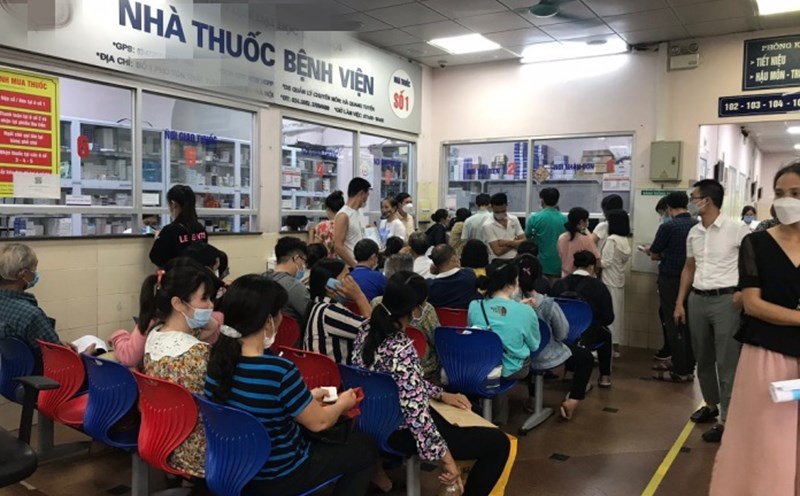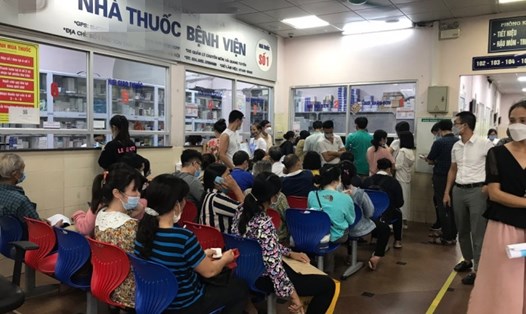Facilities for patients
Going to a hospital in Go Vap district for examination, Ms. Kim Anh (district 10) said that after the doctor examined, she had created a prescription on the software and sent it directly to the pharmacy. After that, she just needs to take the form to the pharmacy to receive the medicine as prescribed.
"After receiving the form, pharmacists will give medicine and print the bill. Previously, every time I lost my prescription, I had to go to the hospital to ask for it, now the doctor sends the prescription directly to my phone" - Ms. Kim Anh shared.
Mr. N.T.M - a patient visiting the Oncology Hospital (Thu Duc City) - also commented: "Previously, every time I examined, I had to carefully keep the prescription, afraid of losing or tearing. Now having an electronic version is very convenient".
Accelerating implementation in Ho Chi Minh City
At Ho Chi Minh City Oncology Hospital, the implementation of electronic prescriptions has been implemented synchronously at both facilities in Binh Thanh District and Thu Duc City.
Doctor Vo Duc Hieu - Deputy Director of the Hospital - said: The hospital has registered and been granted an identification code for electronic prescription for both facilities. All doctors have registered a prescription code on the national prescription portal.
From 2023, the hospital will officially connect electronic prescription data from hospital management software to the National Information System. As of June 11, the two facilities have connected with more than 700,000 prescriptions. This enhances the ability to monitor prescriptions, make the process of issuing and tracing the origin of drugs transparent" - Dr. Hieu informed.
According to him, implementing electronic prescriptions has many benefits: helping to comply with treatment regimens, supporting traceability, controlling drug quality, limiting drug abuse - especially antibiotics, addictive painkillers, expensive pharmaceuticals - thereby improving treatment effectiveness and protecting public health.
Mr. Huynh Ngoc Duong - Vice Chairman of the Ho Chi Minh City Pharmaceutical Association - also commented: Electronic prescriptions are a necessary step to bring the Vietnamese pharmaceutical industry closer to international practices. Therefore, pharmacists cannot arbitrarily let people use drugs without a doctor's prescription, contributing to limiting the habit of arbitrarily using drugs that have been popular for a long time.
Deployment is still slower than required
Although the policy is correct, the progress of implementing electronic prescriptions nationwide is still slow.
Since 2019, the Ministry of Health has built and piloted a national information system on prescription management and prescription drug sales, deployed in Ha Tinh and Hung Yen. The system allows pharmacies to receive prescriptions from the network, sell prescription drugs correctly, control antibiotics and special drugs. Patients only need to provide a code, and can buy it at any pharmacy.
Circular 04/2022/TT-BYT requires hospitals of class 3 or higher to complete electronic prescriptions before December 31, 2022, and the remaining facilities before June 30, 2023. However, the progress is still slow.
According to the Vietnam Medical Informatics Association, there are currently only more than 11,200/60,000 medical examination and treatment facilities that regularly collect prescriptions. Many new end-line hospitals have agreed to prescribe insurance drugs, but have not yet applied to prescriptions as required. About 40,000 private medical facilities and most pharmacies, including in hospitals, have not yet sold drugs under electronic prescription codes.
Of the more than 218 million prescriptions that have been linked, only more than 3.6 million outpatient prescriptions have been confirmed to have been sold at retail establishments.
In Hanoi, some hospitals such as K Hospital, Thanh Nhan Hospital, and the Central Hospital for Tropical Diseases have deployed internal systems, but the data has not been connected to the outside.
Phu Tho General Hospital is a pioneer in testing electronic prescription management since 2020. The hospital representative said that when the doctor prescribes on the computer, the data is immediately synchronized with the pharmacy. Patients only need to provide a full name or code to receive the medicine, without having to bring a prescription.
Bach Mai Hospital has also deployed electronic medical records since the end of 2024. The hospital director - Associate Professor, Dr. Dao Xuan Co - said that the digitization of medical records and prescriptions helps patients no longer worry about difficult-to- read handwritten prescriptions, and at the same time, all prescriptions are connected to the Ministry of Health's electronic information portal, helping to strictly control prescriptions.
Previously, when prescribing by hand, a small number of doctors could connect with businesses to prescribe unnecessary functional foods or medications. Now that we are electronic, managers can monitor more easily, said Mr. Co.
There are still many barriers
According to a survey by Lao Dong Newspaper reporters at many private pharmacies in Hanoi, many places are still quite "struggling" with electronic prescriptions. A.H pharmacy employee on Tran Kim Xuyen street said that he still sells medicine according to paper prescriptions and has never made electronic prescriptions.
Associate Professor, Dr. Tran Quy Tuong - Chairman of the Vietnam Medical Informatics Association - commented that the reason for the slow implementation is not due to technical infrastructure, because 100% of drug retail facilities have appropriate software. The main reason is the lack of determination from medical examination and treatment facilities, especially the private sector.
Although there is many free or cheap software to support electronic prescriptions, some localities have not organized training and closely monitored, causing many private facilities to delay implementation.
Deputy Minister of Health Do Xuan Tuyen said that in the coming time, the Ministry of Health will continue to complete the information technology infrastructure, ensuring that if a person has bought medicine according to prescription A, he will not be able to buy a second prescription A on online stores nationwide.
This is to prevent the act of "borrowing prescriptions", abusing drugs or buying back prescription drugs that have expired.
However, the infrastructure at many pharmacies, especially at district and commune levels, has not yet fully met the requirements. Therefore, the implementation of drug sales via e-commerce needs to be supported more strongly in terms of technology, training and supervision, to ensure the goal: convenient for people, but still safe and effective in drug use management.











